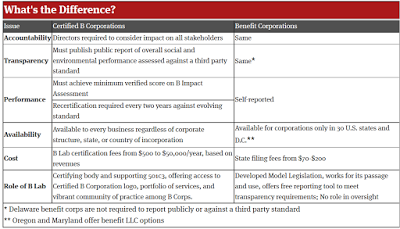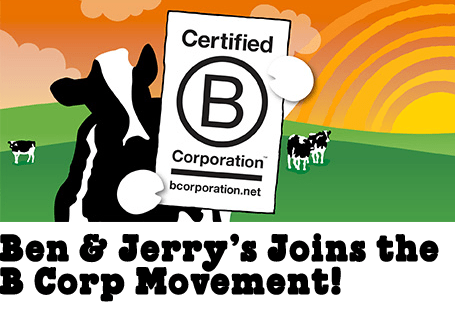
Tuesday I blogged about Benefit Corporations—a relatively new kind of “hybrid” legal structure for mission-driven for-profits. Today’s post is about B Corps—companies participating in a certification program that measures their impact on the world. I wish to heaven whoever made up the names for these entities hadn’t made them so dang similar. I spent the first year I was reading and thinking about them confusing the two, and occasionally mangling the terms. Here’s an ultra-simple primer:
- “Benefit corporation” is a legal status. Companies incorporated as benefit corporations have a legal obligation to deliver both financial and social/environmental returns to their stockholders.
- “Certified B Corporation”—often shortened to B Corp—Is a voluntary certification system available to for-profit organizations. Administered by the nonprofit B Lab, B Corp certification attests that a company is meeting certain criteria to demonstrate how it operates responsibly with regard to the environment, its workers, its customers, its community, and its governance.
How are they related? Benefit Corporations and B Corps are both manifestations of a growing movement to “use business as a force for good” (as B Lab puts it). As such, it is yet another factor “fuzzing the boundaries” between the nonprofit and for-profit sectors. Some companies double down, incorporating as Benefit Corporations andbecoming certified as B Corps.
 |
| Comparison of Certified B Corporations and Benefit Corporations from B Lab |
How does certification work?
To become certified as a B Corps, a company:
- Completes an impact assessment that measures its effect on its community. As with LEED certification, a company has to achieve a minimum score across four segments (governance, workforce, community, environment).
- Meet the legal requirements for certification; including updating the company’s mission statement, getting board and shareholder approval and filing amended articles with the appropriate secretary of state.
- Sign the B Corp “Declaration of Interdependence” and B Corp Agreement
Why do companies choose to become certified as B Corps?
(Over 5700 are listed on the B Lab site.) The reasonslisted by B Lab include a mix of altruism and opportunism. B Lab envisions a day when “all companies compete to be best for the world” in order to create “a more durable and shared prosperity for all.” As I noted in TrendsWatch 2014 (in the chapter For Profit for Good) a majority of consumers care about the behavior and reputation of a company and factor this into their purchasing decisions. B Corps certification is one way for a mission-driven for-profit company to demonstrate it is living up to its ideals. And it can help companies recruit employees: 85% of Millennials want their work to make a difference in the world, and 71% want to work for a company that encourages global or community social responsibility.
What kind of companies decide to become certified as B Corps?
 I’m sure you’ve heard of some of them: Ben and Jerry’s for one, the ice cream company famous for its activism and devotion to the environment and workers’ quality of life. On their B Lab page, they avow their mission to “advance new models of economic justice that are both sustainable and replicable.” The online marketplace Etsy is another, describing themselves as “a people-powered company with a social mission.” Patagonia, a business built around outdoor sports, ties their success to the health of our planet. These three companies are all huge, but many small businesses choose to become certified as well.
I’m sure you’ve heard of some of them: Ben and Jerry’s for one, the ice cream company famous for its activism and devotion to the environment and workers’ quality of life. On their B Lab page, they avow their mission to “advance new models of economic justice that are both sustainable and replicable.” The online marketplace Etsy is another, describing themselves as “a people-powered company with a social mission.” Patagonia, a business built around outdoor sports, ties their success to the health of our planet. These three companies are all huge, but many small businesses choose to become certified as well.
Why should museums care?
As with Benefit Corporations, B Corps represent one more trend blurring the boundaries between for-profit and nonprofit organizations. As more for-profits find ways such as B Corps certification to verify their mission and impact, they will exert pressure on nonprofits to clarify how their own missions are distinct, and deserving of philanthropic support, and to be equally accountable for results.
If more museums choose to be for-profit (I included a short list in the previous post), they could use B Corps certification as a way to demonstrate their dedication to mission and to benefiting their community.
Take some time to browse the B Lab listing of B Corps, read these companies’ descriptions of their work and see how they articulate the “change they seek.” I’ve found a lot of businesses that share a lot of values with our sector, and are in some instances doing related work. In coming weeks, I’ll feature some of their stories on the Blog. Stay tuned.









Comments